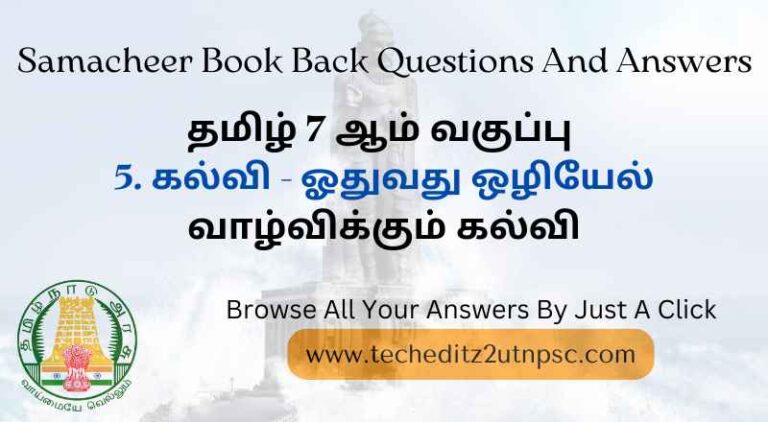support@techeditz2utnpsc.com | 8300-921-521

Movements in Animals
Samacheer Book Back Questions And Answers For Science Standard 8 “Movements in Animals“
I. Choose the best answer:
1. Which of the following parts of our body help us in movement?
(i) Bones (ii) Skin (iii) Muscles (iv) Organs
Choose the correct answer from the options below.
(a) (i) and (iii)
(b) (ii) and (iv)
(c) (i) and (iv)
(d) (iii) and (ii)
2. Which one of the following organisms lack muscles and skeleton for movement?
(a) Dog
(b) Snail
(c) Earthworm
(d) Human being
3. _____ joints are immovable.
(a) Shoulder and arm
(b) Knee and joint
(c) Upper jaw and skull
(d) Lower jaw and upper jaw
4. Why do underwater divers wear fin-like flippers on their feet ?
(a) To swim easily in water.
(b) To look like a fish.
(c) To walk on water surface.
(d) To walk over the bottom of the sea (sea bed)
5 External ear (pinna)is supported by
(a) bone
(b) cartilage
(c) tendon
(d) capsule
6 Cockroach moves with the help of its
(a) leg
(b) bone
(c) muscular foot
(d) whole body
7. Which one of the following categories of vertebrae are correctly numbered?
(a) Cervical-7
(b) Thoracic-10
(c) Lumbar – 4
(d) Sacral – 4
II. Fill in the blanks:
1. Movement of organisms from place to place is called _____.
2. _____ refers to change in position of the part of an organisms body.
3. A structure which provides rigid frame work to the body is called _____.
4. Axil skeleton in human consists of _____, _____, _____, _____ and _____.
5. Appendicular skeleton in human consists of _____ and _____.
6. The place where two bones meet is termed as _____.
7. _____ is attached to soft parts of the body like blood vessels, iris, bronchi and the skin
8. _____ muscle makes pupil of eyes wider.
Answers:
1. locomotion
2. Movement
3. skeleton
4. Skull, facial bones, sternum, ribs and vertebral column
5. Pelvic and Pectoral girdle
6. Joint
7. Smooth muscle
8. Radial
III. State true or false. If false, correct the statement:
1. Skull in humans consists of 22 bones.
2. There are 12 pairs of ribs in human body.
3. Pelvic girdle is a part of axial skeleton.
4. Hinge joint is slightly movable joint.
5. Cardiac muscle is a voluntary muscle.
6. The flexor and extensor muscle of the arm are antagonistic muscles.
Answers:
1. True
2. True
3. False (Pelvic girdle is a part of appendicular skeleton)
4. True
5. False (Cardiac muscle is a involuntary muscle)
6. True
Visit Our YouTube Channel For More Free Videos: Click Here


